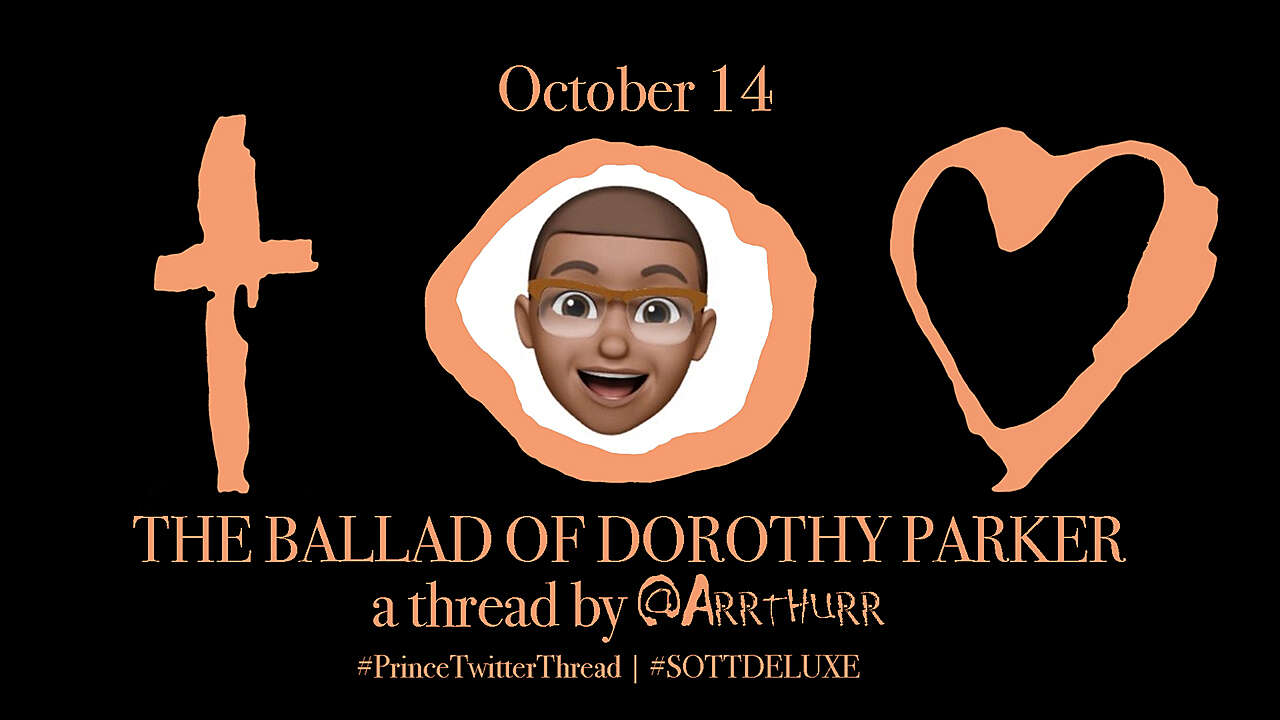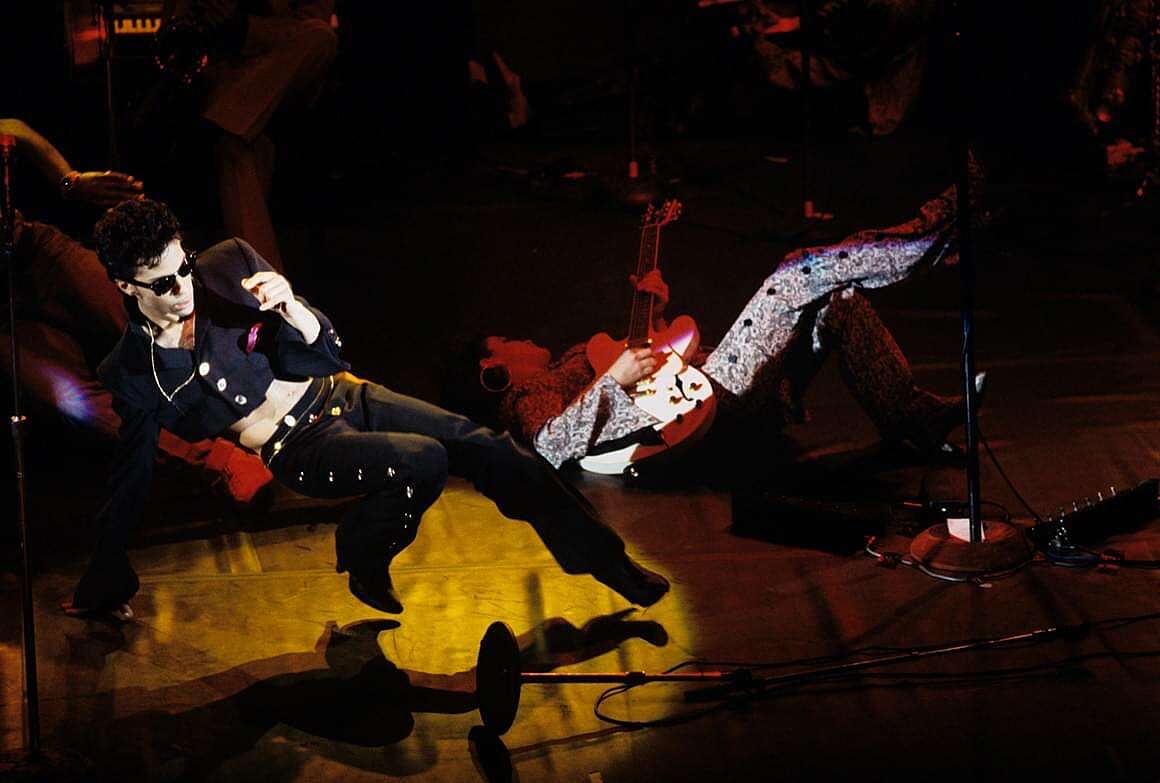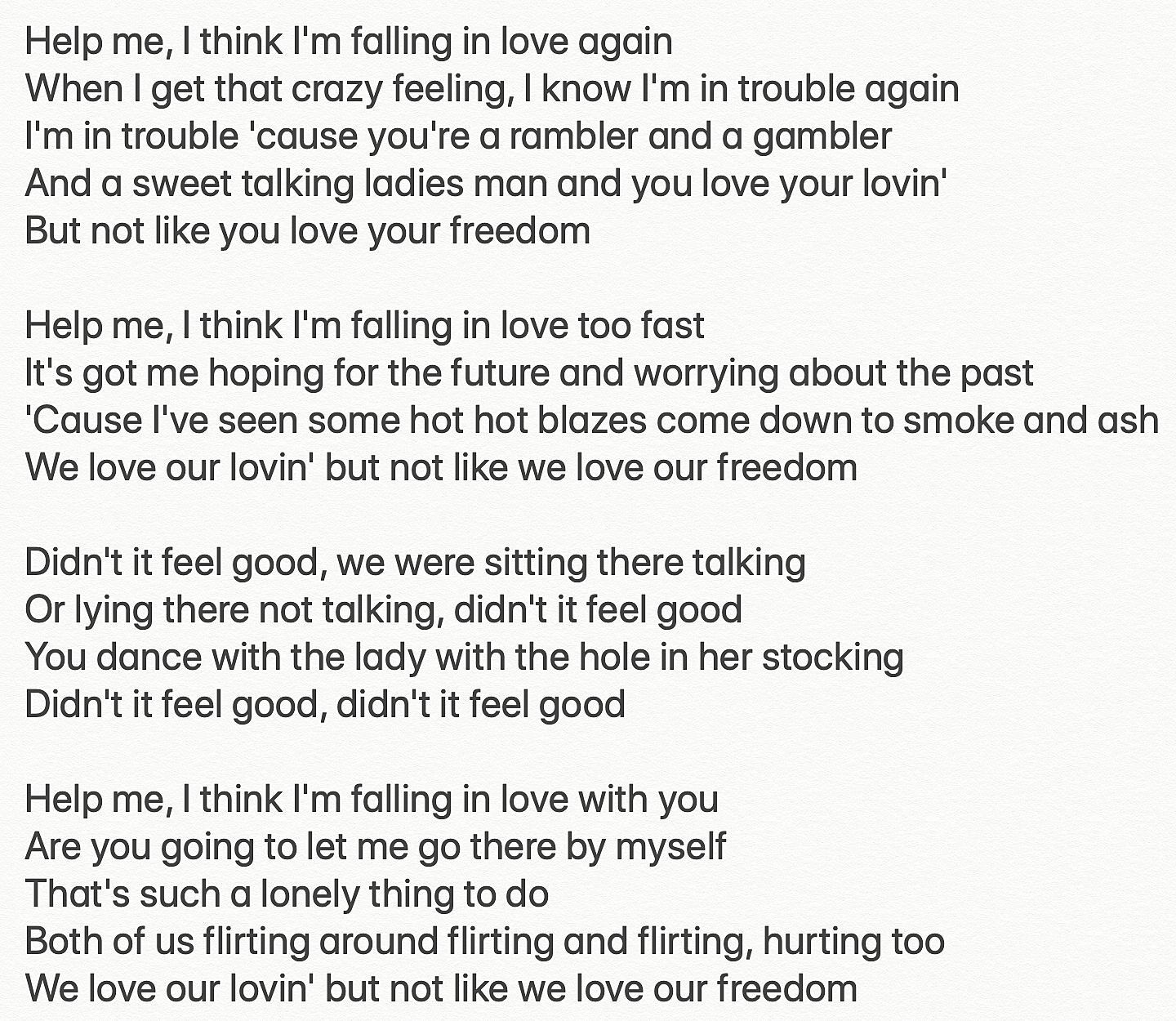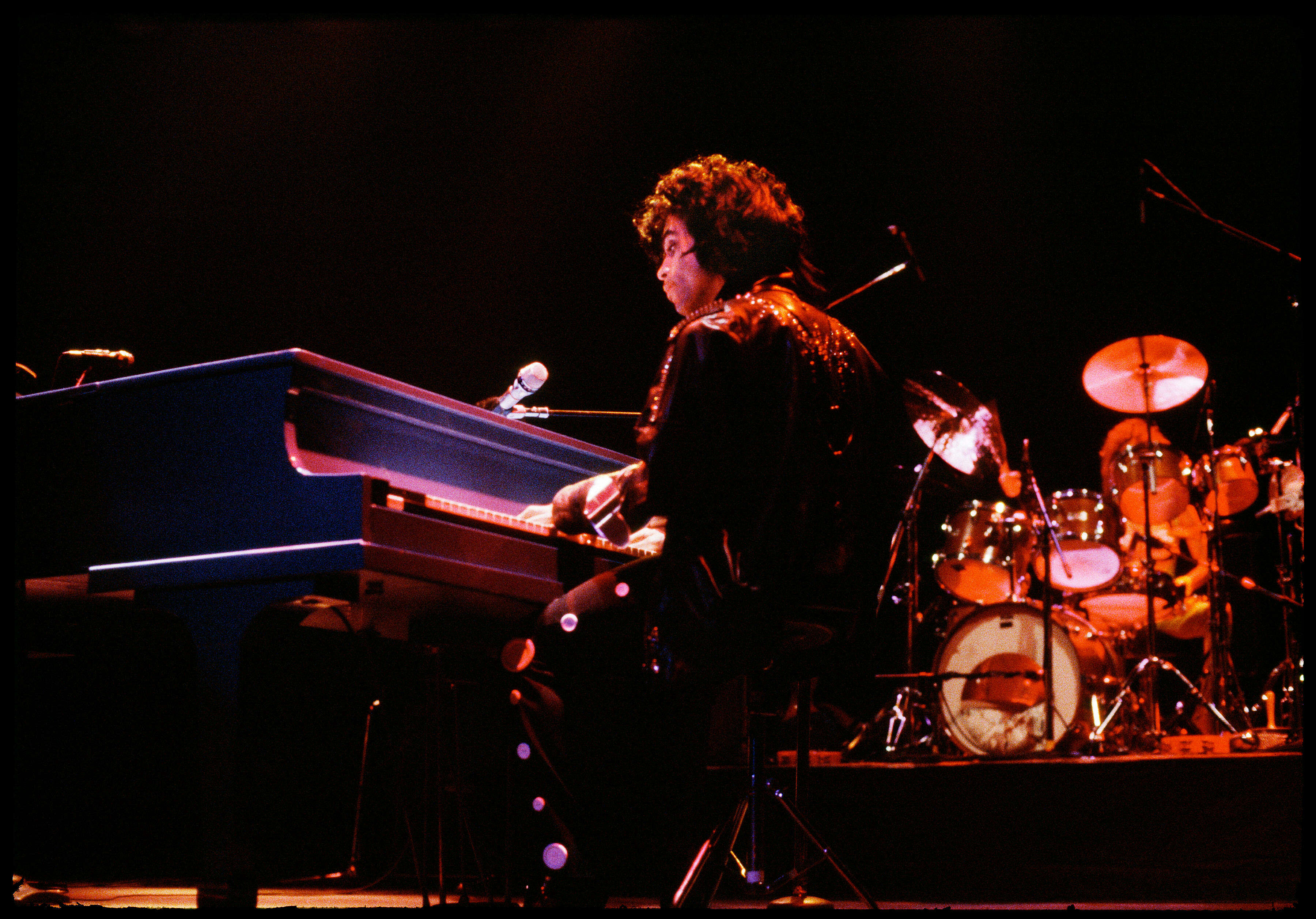
"Dorothy was a waitress …"
This opening line of "The Ballad of Dorothy Parker" (TBoDP) — the cult-iest of Prince cult classics — is as resonant a song opener as "Dig if U will…", "I was dreaming when I wrote this…", or "I guess I should've known…" despite not being a hit single. Let's start with some background:
An expert account of the making of TBoDP is from engineer Susan Rogers and can be heard at the 9:22 mark in pt. 2 of Anna SOTT podcast.
TL;DR: In early 1986, Prince had a studio built in his new home. And because he was so anxious to start working, sent Frank De Medio, a studio legend who built the mix console, home before completing the necessary troubleshooting. TBoDP was the first song recorded. Thereafter, Prince brought in lyrics based on a dream. And according to Rogers, he recorded drums in one take, w/ his lyrics likely taped to a tom, as he sang the song in his head. Of course, we hear the LM-1 drums, but according to Rogers he's playing — and he's not playing to a click track (think metronome). Prince also played the remaining instruments. While taping, Rogers discovered the console's output sounded "muffled". Knowing better than to stop his creative flow, she let Prince work. Despite the loss of high-end, he liked the finished product. The quote: "This console's nice. It’s kind of dull, isn't it?"
Prince and Susan Rogers recorded & mixed TBoDP, start-to-finish, in roughly a 24-hour period during March 13-14, 1986. We'll come back to these dates.
For the uninitiated, recording artists would swear by consoles. They're central to the sound of a song. In fact, Dave Grohl made the documentary Sound City based solely on his purchase of the Neve 8028 analog console used to record Nirvana's Nevermind. It's deep; trust me.
What made Prince's API/De Medio console (now housed in Studio B at Paisley Park) so special, was that it's based on the one used by engineer Peggy McCreary at Sunset Sound for Controversy, 1999, Purple Rain, and Around the World in A Day. That console was maintained by Frank De Medio, which is why Prince hired De Medio to build one for him.

Why spend this much time over a mix console? Because it's the very reason TBoDP sounds the way that it does. It adds to the song's character. And because Rogers fixed the "problem" that manifested while Prince was recording, every song thereafter benefited from the API's full capabilities. Put literally: no other Prince song sounds like "The Ballad of Dorothy Parker."
Now, back to the aforementioned dates. What was happening mid-March 1986? A lot, actually: "Kiss" was in Billboard's Top 20 (as was the Prince-penned "Manic Monday" by The Bangles); the Parade album was a couple of week's away from release; and tour rehearsals were in full swing. Also, not a week before recording TBoDP, Prince and the Revolution made a cameo appearance at Sheila E's San Francisco show on March 8, 1986.

What makes this bit of context so interesting is that it demonstrates how Prince operated in two timelines: one for Right Now and another for What's Next. (But, that's an aside, so I'll get back to "Dorothy" and try to stay on topic.)
It would be interesting to know if Prince had the dream that prompted him to write TBoDP after he got back from the San Francisco Bay Area. While I would presume that he did, there's always a fine line between what happened and what you'd want to have happened. Here's what I mean: much of what makes TBoDP unique is that it's more of a production than a song. The mood that Prince created is what draws you in. What this means is that the song is all feel, and it's a key as to why the live versions are so different from the original. (Hold that for later.) But you know who else was really good at harnessing mood and feel into their music? Sly Stone.
To be clear, I'm not suggesting that Prince visited the Bay Area and was magically inspired to write TBoDP. But I am acknowledging that inspiration comes from many sources, and P had several influences that hail from that part of California. Okay – I'm moving on…
One last part about the music before I get to the lyrics, and it's a somewhat advanced topic: the pedal point or repeated tone. It's a technique where you repeat the same note in each chord throughout an entire section of a song, which can create dissonant or unexpected harmony. TBoDP uses the note of E as the pedal point tone in the A-section. A couple of the chords don't naturally feature an E at all. This gives the song an unpredictability, and gives the chord progression a floating quality befitting the uncommon vibe of the song. Now, on to the lyrics…
Ultimately, "The Ballad of Dorothy Parker" is a song about self-care. Let's unpack.
Lyrically, Prince is narrating an experience. We have three voices: the narrator (Prince), Dorothy's, and a proxy for us to join the conversation. ("What you say?", "Tell us what you did.", etc.) Apart from a single couplet, none of the lyrics rhyme; this is very stream-of-thought.
Prince is in a café on a promenade, and I'd bet the farm that he visualized France in his dream. He'd been in Nice for months shooting "Under the Cherry Moon," and there is a seven-kilometer walkway called the Promenade des Anglais. So anyway, at tis café, Prince meets Dorothy Parker, a nightshift waitress with great people skills. Now he's there to escape a heated conflict and clear his head ("Earlier I'd been talking stuff in a violent room/Fighting with lover's past"), and he orders — of all things — a fruit cocktail. This triggers an attraction from Dorothy ("You're kinda cute, you wanna take a bath?").
Say what you want about Prince, but he's always been a promoter of cleanliness. He agrees to the bath on the condition that he leaves his pants on "because I'm kinda going with someone" — a relationship that may or may not have been complicated by what went down in that violent room. At some point during the bath, Prince's pants come off. But — and this is important — Dorthy doesn't look at him. ("Instead she pretended she was blind/An affliction brought on by a witch's curse") After the bath sequence, Prince returns to the aforementioned violent room, repeats the bath ritual, and resolves his conflict. This is all based on his connecting w/ Dorothy.
The bath sequence provides some insight about Dorothy. Despite their questionable choices, no sex takes place. We don't even know if she got into the bath w/ Prince. And Prince wanting to keep his pants on shows him drawing a line at how far he's willing to go before completely breaking trust with the someone he's "kinda going with." We could even call this "safe sex". In Jan 1986, public health experts predicted twice as many new AIDS cases for that year & Prince was well aware of this atmosphere. TBoDP gives us a restrained Prince. (As much as you can get from a guy who accepts a stranger's bath invite.) And for Dorothy's part? "But she didn't see the movie, cuz she hadn't read the book first." A refrain from sex before getting to know Prince. (As much as you can get from a woman who invites a stranger to take a bath.)
Now about that song on Dorthy's radio. It's the most information about Dorothy Parker that we get. Joni Mitchell's "Help Me" is about a woman who's quick to fall in love, even though the object of her affection may not reciprocate. But she loves the feeling of being in love. This is Dorothy Parker, and "Help Me" is her "favorite song" ("Help me, I think I'm falling in love again").

Dorothy immediately falls "in love" with Prince at first meeting (Joni's next lyric: "When I get that crazy feeling, I know I'm in trouble again"), despite it being a bad look. And we know she looks away when his pants come off in the bath. Here, we see that Dorothy Parker is not Darling Nikki.
In closing, I want to shine a light on the legacy of TBoDP. Prince played it live several times using a very different arrangement in the late 1980s and throughout the 2000s. It's also evolved over the years. Here's an official, late-career version as part of the One Night Alone box set. This is an arrangement many are familiar with, he also played it during an appearance on the Tonight Show with Jay Leno. Note that bassist Rhonda Smith is playing a line that Prince plays on synth in the recording. But there are earlier versions from 1987 that more closely follow the original song structure. Then, bassist Levi Seacer Jr. would play the bass line as heard on the release of Sign 'O' the Times. (Consult your favorite bootlegger for details.)
So, whichever bass line Prince wanted to use, it could potentially affect the feel of the song's performance. In both cases, he either segues or incorporates Madhouse's "4" to stretch out the arrangement, making the song that more interesting. And while Prince did play TBoDP only once during the Sign 'O' the Times European tour (in Vienna, Austria), it was always a favorite addition to tour after shows. (Below is a photo during the San Francisco performance in November 1988.)

===
Originally posted to Twitter on October 14, 2020